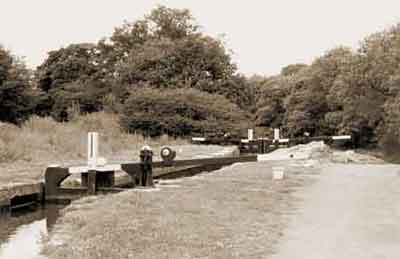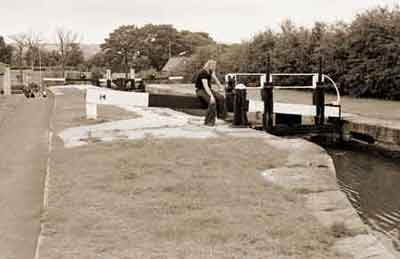Peak Forest Canal
Overview of Marple Locks
There are 16 locks in the Marple flight and the photos in the slideshow are all dated 1978. To view the slideshow click on the photo of Lock 1, bottom lock, and move forward by clicking the right side of each photo.
The Rise of a Lock
This is taken to be the vertical height of its bypass (or overflow) weir above that of the bypass weir of the lock below it.
In the the case of the Peak Forest Canal the Deposited Plan of the Marple flight recorded the overall vertical rise to be 212 feet but at this stage the number of locks to be built had not been agreed upon.
The Committee of the Peak Forest Canal Company recognised that the flight would be steep and they twice requested their engineer, Benjamin Outram,
to reconsider the number of locks in the flight. In the event, Outram settled on having 16 locks in the flight.
Nevertheless, according to a survey of 1894, the flight rose by 209.60 feet (209 feet 7.2 inches) with the rise of individual locks varying between 12 feet 7 inches and 13 feet 6 inches.
Statistics of Marple Locks based on the Ordnance Survey of April 1894
These locks are among the deepest narrow locks in the country and the Upper Peak Forest Canal is the second highest canal pound, the highest being the summit pound of the Huddersfield Narrow Canal at 645 feet.
Due to severe financial constraints on the Peak Forest Canal Company, the construction of Marple Locks took many years to complete and to overcome the delay the temporary Marple Tramway was built to bypass the unfinished locks.
| Oct 1795 | The Committee instruct Benjamin Outram to stake out the line of Marple Locks but groundwork only commenced on locks 1 to 4. |
| Jul 1796 | The Committee considered that it was not entirely obligated to building locks and it examined a range of options. In contradiction to this, the site of lock 16 (Top Lock) was agreed upon and this determined the location for the construction of Samuel Oldknow's lime kilns. |
| Feb 1797 | The Committee resolved that locks shall be built at Marple and groundwork started on locks 6, 7, 8 and 9. |
| Mar to Oct 1797 |
Groundwork started on locks 13, 14 and 15. There was no mention of lock 16 and it can be deduced that this was in an advanced stage of construction. |
| Oct 1797 | All work on the locks was suspended and it was decided to build the temporary Marple Tramway. |
| Jan 1798 | Work commenced on construction of the tramway to bypass the unfinished locks. |
| May 1798 | The tramway opened with a single track having passing places. |
| Aug to Oct 1801 |
It is likely that there was limited construction work on the locks. |
| Nov 1802 | It is believed that some groundwork for the locks was underway. |
| Nov 1803 | Groundwork was complete and work started on building the locks. |
| Aug 1804 | The locks were in an advanced state of completion. |
| 13 Oct 1804 | Locks 13 to 16 opened. These four locks gave Samuel Oldknow canal access to both the top and bottom of his newly built lime kilns. |
| Oct/Nov 1804 |
It is understood that construction of lock 6 was completed during this period. This was the last one to be completed but the locks were still not open throughout for navigation. |
| 12 Nov 1805 | Marple locks were open throughout on, or shortly before, this date. The most likely date lies somewhere between the 1st and 12th day of Nov 1805. Although the locks were then open for trade, their construction was by no means complete. |
| Feb 1807 | Marple Tramway closed. |
| Jun 1811 | The Committee of the Peak Forest Canal Company, Thomas Brown (now the Consulting Engineer)
and the Agent of Richard Arkwright Jr agreed that all construction work on Marple Locks was complete and that no further work was
needed other than routine maintenance. Richard Arkwright Jr of Rock House and Willersley Castle, Cromford, Derbyshire, was the major financier for the construction of the locks.
of Rock House and Willersley Castle, Cromford, Derbyshire, was the major financier for the construction of the locks. |
















